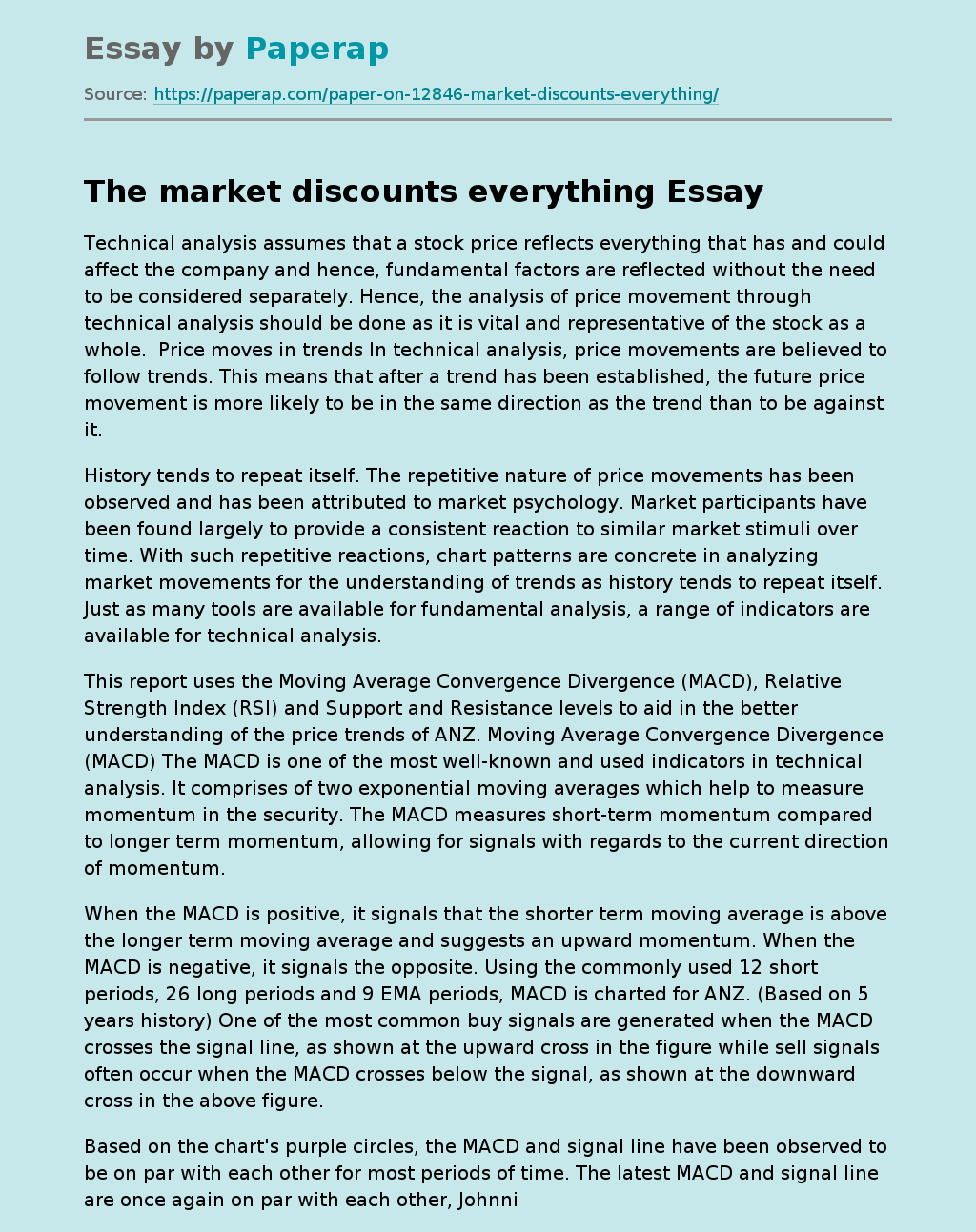The market discounts everything
Technical analysis assumes that a stock price reflects everything that has and could affect the company and hence, fundamental factors are reflected without the need to be considered separately. Hence, the analysis of price movement through technical analysis should be done as it is vital and representative of the stock as a whole. Price moves in trends In technical analysis, price movements are believed to follow trends. This means that after a trend has been established, the future price movement is more likely to be in the same direction as the trend than to be against it.
History tends to repeat itself. The repetitive nature of price movements has been observed and has been attributed to market psychology. Market participants have been found largely to provide a consistent reaction to similar market stimuli over time. With such repetitive reactions, chart patterns are concrete in analyzing market movements for the understanding of trends as history tends to repeat itself. Just as many tools are available for fundamental analysis, a range of indicators are available for technical analysis.
This report uses the Moving Average Convergence Divergence (MACD), Relative Strength Index (RSI) and Support and Resistance levels to aid in the better understanding of the price trends of ANZ. Moving Average Convergence Divergence (MACD) The MACD is one of the most well-known and used indicators in technical analysis. It comprises of two exponential moving averages which help to measure momentum in the security. The MACD measures short-term momentum compared to longer term momentum, allowing for signals with regards to the current direction of momentum.
When the MACD is positive, it signals that the shorter term moving average is above the longer term moving average and suggests an upward momentum. When the MACD is negative, it signals the opposite. Using the commonly used 12 short periods, 26 long periods and 9 EMA periods, MACD is charted for ANZ. (Based on 5 years history) One of the most common buy signals are generated when the MACD crosses the signal line, as shown at the upward cross in the figure while sell signals often occur when the MACD crosses below the signal, as shown at the downward cross in the above figure.
Based on the chart’s purple circles, the MACD and signal line have been observed to be on par with each other for most periods of time. The latest MACD and signal line are once again on par with each other, Johnnie can buy the stock as based on past trends as it is hardly that the MACD goes below the signal line. Relative Strength Index (RSI) The RSI is another well-known and used tool in technical analysis. It helps to signal overbought and oversold conditions in a security. Plotted in a range of 0 to 100, a reading above 70 is used to suggest that a security is overbought while a reading below 30 is used to suggest that it is oversold.
This indicator helps traders to identify whether a security’s price has been unreasonably pushed to current levels and whether a reversal may be on the way. A RSI is charted for ANZ based on its 5 years history, suggesting the periods over the 70 reading to have been overbought and those under 30 to have been oversold. Based on the chart above, the latest showings by ANZ signalled by the purple circle are within the boundaries, signalling that it is not overbought or oversold.
As such, it is a good time for Johnnie to buy the stocks since they are not unreasonably priced. Support and Resistance A security price seldom moves above its resistance or below its support level. Support and resistance levels are important in terms of market supply and demand as traders are willing to buy the stock at support level and sell it at resistance level. Once these trends are broken, it is thought that supply and demand have shifted and a new support and resistance level will likely to be established.
Based on the last third quarters of 2009 and first three quarters of 2010 history of ANZ, its support and resistance level is established at resistance level approximately AUD$24. 50 and support level approximately AUD$21. Based on the latest showings of ANZ (purple circle), the stock price is predicted to rise at least till its resistance level. As such, Johnnie should buy the stock now as there are rooms before the stock price hits resistance. Besides, the last time the stock price hit resistance level (black circle), it moved slightly above resistance.
Based on ANZ’s current showings, there is a high possibility for price to move up another resistance level. Price Predictions The above chart resembles a breakout from the price convergence pattern of the upside over the medium term (3-6months) and suggests a rising trend with a short term target of 2/3rds the depth of the price convergence pattern. This is roughly $24 + (2/3 x (25. 80-21)) or $27. 20. This prediction of a rise in price can be further justified with by the current stock market which is on its way to recovery after going down from the period of April to July 2010.
As the stock market recovers, ANZ stock will be positively affected as well. (Source: http://www. tradingeconomics. com/default. aspx) Australia’s economy on the whole has also been doing well since the start of 2010. The major indicator of the macro-environment, Australia’s GDP Growth Rate has been buoyant with a significant positive increase in the third quarters of 2010. With the economy performing well as a whole, the price prediction of ANZ rising can be further justified.
The market discounts everything. (2018, Jan 17). Retrieved from https://paperap.com/paper-on-12846-market-discounts-everything/

